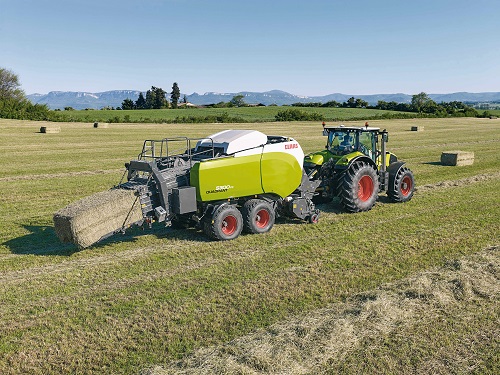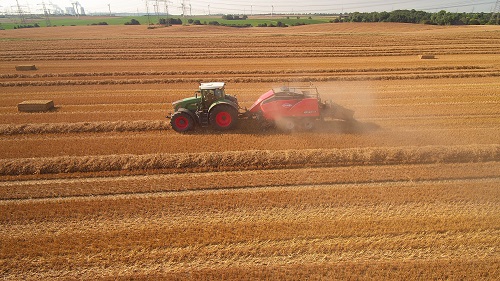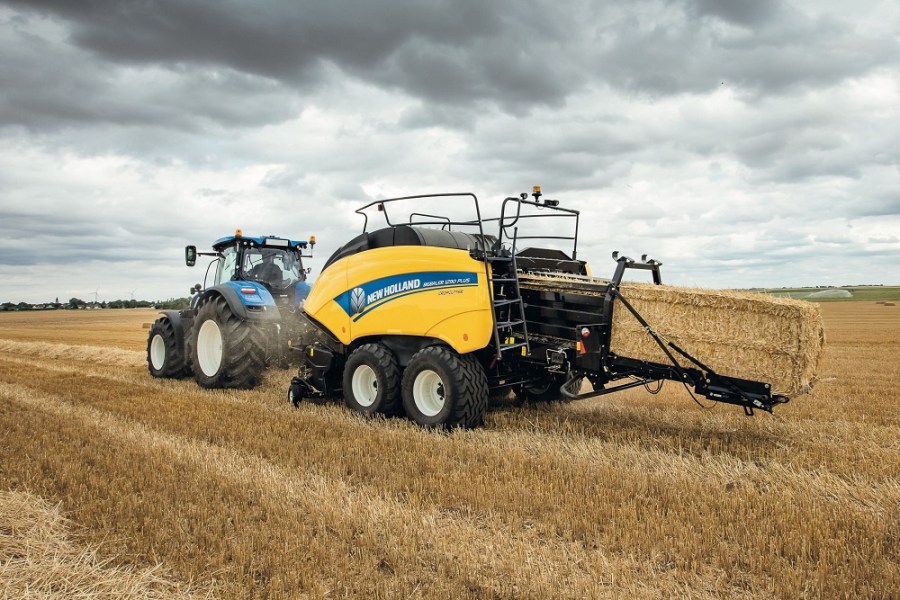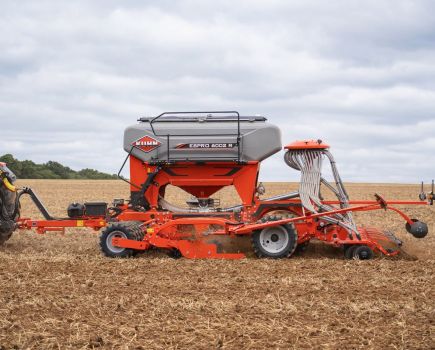Big square balers are packing more biomass into each bale in the field, and come bristling with new features. CPM picks out the highlights.
I think most people who want heavy-duty high-density balers are mainly going for the improved bale weights.
By Jane Brooks
Although probably only feasible for large-scale farmers or agricultural contractors, it’s the lower carting costs, less time in the field and reduced storage capacity that’s leading to growing interest in high-density, high-output square balers.
That’s the view of Toby Morley, baler sales manager for Ernest Doe and Sons, who also believes that power station demand is driving bale size and density. “In our area, most power stations now accept these bigger 1290-sized bales, so in future you can see them all going this way. Hence why companies have been developing high-density balers of this size,” he explains.
Earlier this year, New Holland introduced its largest baler yet, the flagship BigBaler 1290 Plus. It features a 2.3m pick-up and an 80cm longer bale chamber than the previous model delivering up to 10% more density. New Holland says costs per bale are lower as there are fewer bales per ha and fewer bales to transport, cutting down on handling time.
The baler’s fully ISOBUS-compatible IntelliCruise feed rate control system regulates tractor speed in relation to output, ensuring an optimal crop feeding rate. The SmartFill feed flow direction sensing system indicates which direction operators should drive over the swath for even bale formation.
A new biomass kit makes short work of biomass material and the MaxiSweep pick-up design improves productivity, says New Holland. It also has a double knot system designed for high bale density, but with lower knotting strain, reducing the risk of twine snapping.
Toby Morley reports that two New Holland BigBaler 1290 Plus models will shortly be wending their way to customers from Ernest Doe and Sons.
“We’re also running a BigBaler 1290 Plus demo model at the moment and had a test machine last year. I spent a couple of days with it towards the end of the season; we put around 350 bales of wheat straw through it over a weekend when it was on demo with a local farmer. It was baling a nice and uniform square bale, I think the longer it stays in the chamber the better, and it also had noticeably straight edges.
“Actually the farmer that had the demo model for most of the season last year ended up buying one, so he was happy with the product.”
New line-up
The 2017 Claas Quadrant baler line-up has seen the 2200, 3200 and 3300 ranges replaced by 4200, 5200 and 5300 machines, although the Quadrant 4000 (80cm x 50cm) and 2100 (80cm x 70cm) models remain the same.

The Claas Quadrant 5300 delivers improved output and bale density, with heavy-duty drive systems, strengthened knotters and a powerful cleaning package.
The new balers deliver improved output and bale density, together with 5% increased bale chamber length on the 4200 and 11% on the 5200/5300 extending bale chamber length to 3.45m on the 5300. There are heavier duty drive systems, strengthened knotters and a more powerful cleaning package.
An option of hydraulic drive for the pick-up reel, double crop roller and Power Feeding System (PFS) auger enable the pick-up speed to be adjusted according to the crop. What’s more, the auger and press will reverse to aid blockage removal.
Claas’ new-patented Automatic Pressure Control (APC) system is standard on Quadrant 5200 and 5300 models and optional on the 4200. APC automatically maintains bale weight by monitoring the knotters and the stress on the drive system.
The required bale density and quality of baling string being used is entered into the ISOBUS terminal, then by monitoring sensors recording the deflection of the main beam and knotter tension on three of the knotters, APC automatically maintains the target chamber pressure.
The knotter system fitted to all three models features a new bill hook, string guide finger and string clamping plate and disc design, which creates a single, improved shape of knot with longer ends for greater ‘hold’ in all baling conditions with no string waste.
Available as an option on the Quadrant 4200 and standard on the Quadrant 5300/5200, the Knotter Control System (KCS) uses sensors to monitor stress on all six knotters to detect any broken strings or a missed knot, triggering an alarm on the control terminal to alert the driver if there’s a problem.
High capacity baling
Kuhn Farm Machinery has added a new high-density, high-capacity machine to its LSB square baler range. The new LSB 1270 DX completes the company’s range of large square balers in the 120cm x 70cm (2×4) sector.

Baler round-up Khun LSB 1270 DX (1) @300 (use with story):
The new Kuhn LSB 1270 DX is capable of producing 10% more dense bales when compared with previous models.
The LSB 1270 DX is capable of producing bales 10% more dense when compared with previous models and can increase working capacity in dry or bulky swaths by up to 15%. Pick-up intake width is 2.3m and bale chamber length is 3m.
The baler is equipped with a double knotting system – six knotters tie the bale halfway along the bale’s length as well as at the bale end. The system is constantly monitored by the machine’s electronic control terminal, which manages twine tension and gives a knotter failure alert, additionally the new Xtra gearbox design gives up to 30% extra load capacity compared with the previous model.
A revised ‘Xtra’ main frame and bale channel handle the increased loads created by the Xtra gearbox and larger diameter bale channel cylinders create greater friction in the bale channel thereby increasing bale density.
An optional, mechanically driven crop roller, protected by a cam clutch, further enhances baler capacity by up to 15% compared with standard machines.
Chop and change
Not every farmer is in the market for a range-topping high-output square baler and the good news is that round baler manufacturers are also now supplying more high-density options.
Lance Howey of Broomiebank Farm in the Scottish borders was offered a demo of the new Pottinger Impress 185V Pro round baler from Lloyds of Kelso.
“We decided to try it out on a field of silage that had been cut the day before. The baler handled a large quantity of grass well, with us putting three 8ft (2.4m) rows into one with our Pottinger twin rotor rake.
“As the day progressed we went on to bale a field for hay and with the three stage of density adjustment, we made some good shaped bales of hay as the sun shone.”
The Austrian manufacturers heavily anticipated Impress round balers finally broke cover at last month’s Muck and Grassland Event with general availability in late 2017.
The Impress is available in Master or Pro models, with fixed or variable-chambers, together with a bale-wrapper combination.
New Liftup technology, using Pottinger’s patented spiral configuration of rotor tines, means the crop can enter the bale chamber at an ideal angle. Pottinger says this results in high intake capacity and high baling performance with very low disintegration losses.
The crop is actually fed over as opposed to under the pick-up reel. The feed rotor is positioned above and behind the pick-up reel and rotates backwards.
What’s more, the bale chamber is fed more uniformly across the whole width, greatly reducing the need for any left or right steering correction and weaving.
The “Flexicut 32” short chop system offers up to 32 twinblade reversible knives and Pottinger’s individual knife protection system. The knife bank is located over the feed rotor; for servicing it can be pulled outside of the bale chamber at what Pottinger call workbench height.
Various knife configurations can be chosen. When all 32 are in use a theoretical chop length of 36mm is possible, which Pottinger says enables higher crop compression for a higher density bale.
Developed to meet the high-capacity requirements of contractors and larger livestock farms, John Deere’s new C441R premium wrapping baler incorporates a heavy-duty drive system rated at up to 210hp with 1000rpm pto.
The new 18-roller bale chamber has increased in width, from 117 to 121cm. The baler features further enhancements designed to improve the machine’s overall durability and performance in heavy, wet grass crops and dry straw.
The wrapping unit now has a 15% faster wrapping arm working at 40rpm, and the 18% faster table transfer system delivers a further big increase in productivity.
There’s a choice of 2m or optional 2.2m pick-ups, feeding a high capacity MaxiCut HC rotor with 13 or 25 knives. The baler also incorporates a full width parallel drop-floor system operated from the tractor cab, which enables blockages to be removed instantly.
The machine is available with a single axle or with an optional tandem axle chassis for improved stability.
Krone’s BiG Pack balers are now available with the company’s VariCut (VC) cutting system. Available on the BiG Pack 1270 and BiG Pack 1290 HDP, VariCut features 51 knives mounted in a cassette and can be used in standard combinations of 51/26/25/12/5 or 0, with 51 knives producing a nominal chop length of 22mm.
Krone says the VC system produces short chopped straw in the field, which is easy to handle and use. The crop is fed through the knives by a rotor cutter, featuring a forth row of tines to maintain a smooth flow of crop into the variable fill system pre-chamber and achieve higher throughputs.
Knife combinations are easily engaged by the turning of a camshaft. An integral air-cleaning system minimises material build-up around the knives and protection springs. The blade cassette and floor can be lowered with minimum effort to remove blockages. The cassettes are also quickly removed for cleaning and maintenance.
Field shredders for biomass baling
Kuhn’s WS 320 BIO is a front mounted specialist biomass shredder for harvesting high volume energy crops such as Miscanthus. It’s designed to be used in conjunction with a baler for single-pass shredding and harvesting.
It has a 3.23m working width and is fitted with a central rear opening and hydraulically driven worm screw for windrow formation. 72 Y-shaped shredding knives are mounted on a 220mm rotor which turns at a relatively low speed to deliver a coarse shredding action: the machine typically produces chopped fibres in excess of 15cm in length, making it easier for the following baler to pick up the crop.
Cutting height can be adjusted from 4 to 15cm and the machine has a recommended tractor power requirement of 150-300hp.
Kuhn says that by using the shredder in conjunction with a baler it’s possible to reduce the shredding and baling process to a one-person, one-pass operation for faster, more efficient harvesting.
In field pellet production
German manufacturer Krone have come up with an alternative to baling or ensiling forage or straw – the Premos 5000, which they say is the world’s first full in-field pellet harvester.
The trailed machine is a similar concept to a tanker harvester, but produces pellets from windrowed material directly in the field, cutting out the need for chopping or any other pre-treatment. In effect, it replaces the entire harvest chain of baling, bale collection, haulage, handling, storage and pelleting.
Furthermore, the machine uses only half the energy normally required for pellet production by stationary plants. Krone say a production rate of up to 5t/hr is achievable and that the pellets have a higher bulk density than straw bales, which means greater quantities of material can be transported at less cost.
Another advantage of Premos 5000 is the fact that it can also be used year round to produce pellets if buyers opt for a bale splitter.
James Duggleby of Krone says that the machine should be commercially available within the next two years or so. “It has created a lot of interest because people see it as a viable alternative to baling straw. Potentially pellets can be produced to suit various uses such as for feed, bedding or in the renewable energy sector.
“There’s an integral intelligent wetting system if the material being pelleted is too dry and also the option of a molasses pre-treatment to improve feed quality. There’s also on-going research with regards to die sizes to enable the production of different sized pellets.”




